#and Just be the Grinning Man for Josiana and the crowd
Text
(long unnecessary rambles ahoy)
thinking about the Smiling Songs and how in the first one, Gwyn initially seems super uncomfortable with the attention and tries to pull away from everyone touching him. he eventually settles and even initiates contact, becoming enthusiastic as the scene progresses, but still has that...almost shy kind of posture as he first starts to take off the bandages, with his head angled down and his arms positioned in such a way as to (somewhat) block his face from view?
i still don’t see these scenes as happening literally, but considering that it comes right before Labyrinth, wherein Gwyn tries to decide to give up on his past, i wonder if it’s not a bit representative of the kind of internal struggle Gwyn’s going through. On the one hand, he hates feeling like people don’t see him when they look at him, like they only see “this freak”. He feels like he doesn’t have a sense of self, that he won’t have a sense of self outside of The Grinning Man unless he can discover his past, and that makes him unfit for Dea’s love.
But on the other hand, he does want love and affection. Even if that affection is for, as far as Gwyn’s concerned, someone who’s both not really him, and someone he’s afraid of being and doesn’t want to only be seen as. Later on in Labyrinth, he says that Josiana “sees the beauty in [his] broken face”, and that can of course also be taken as, she’s seen his face and isn’t repulsed by the sight of his wound, but i wonder if it’s also kind of...connected to the reaction he’s seeing from the crowd?
As in, to her, and to them, the beauty is the broken face, and nothing else. It’s the anguish and the anger and the present sort of hopelessness that make people feel things. Not the actual person. They see Gwyn and they make it about how they feel.
Labyrinth and Brand New World follow Gwyn’s decision to...lean into that, i guess, and kind of embrace that this is what people want from him. And really he starts thinking in that direction as soon as he gets the letter, but i think his participation in the Smiling Song really illustrates where his mind is.
On that note i also find it interesting how Gwyn’s the only person who doesn’t actually sing or speak during either smiling song. For the first one, Barkilphedro, Dea, and Ursus are absent, but they all participate to some degree in the second one. Gwyn engages with the ensemble both times, but stays silent.
And in the second one, he doesn’t show his actual face at all. He stays facing away from the audience until after he’s picked up the Giant Awful Puppet Head, which he then holds for the rest of the song.
The second Smiling Song in particular, i see as being more Barkilphedro’s perspective than anything, and being in a kind of sarcastic tone. Barkilphedro doesn’t understand why everyone seems to ‘worship’ the Grinning Man, and people attributing miracles to him could just be another facet of Barkilphedro’s sneering disdain for the whole matter.
But also, given the whole tl;dr of ... the entirety of Labyrinth and the decision to meet Josiana- of Gwyn being just as terrified of remembering his past as he is desperate to do so, being afraid and, really, at least dimly understanding and therefore dreading, that remembering, that even finding and killing the man who cut him won’t actually heal him, not fully and completely like the fairy tale prince, and given the heel-face turn from “how can I give you my heart when there is nothing at its core” and “how can you love me when you don’t know me”, as if he’s more of a placeholder for the identity he can’t remember than a full person already, to immediately wanting to marry Dea... and given the way that Ursus and Dea actually participate in the second Smiling Song,
i still feel like it’s mainly Barkilphedro’s pov since he is the narrator and so technically everything that happens is run through that filter, plus Gwyn wouldn’t have known to include “father, what have they done to you/I will bandage your wounds for you”, but it’s also a multi-pov show even when those pov are happening simultaneously, so
reckon whether it mightn’t also be reflective of Gwyn maybe feeling like learning this little bit about his past gives him enough sense of identity that he can...do both, in a way? To have enough sense of self that he feels there’s enough to him to give Dea, and as if he doesn’t have to pursue the rest of his past any further? He might think that this will let him ‘bury his pain’, like Ursus has wanted him to do.
it could be worth noting that, while Angelica is the only person to respond to the sight of Gwyn’s wound by demanding justice for him, she also doesn’t respond compassionately to the knowledge of whom he is until after she sees his face. she doesn’t acknowledge the fact that he’s been recently beaten. she acknowledges the wound from 20 years ago. This, after Dirry-Moir also completely ignores the fact that Gwyn’s shackled and shirtless and bruised, and instead chatters at him about the show and then directs Angelica to look at Gwyn’s face. All of which gives Gwyn another example of people not seeing him but rather his wound and how it makes them feel.
lastly, and a smaller thing, after 20 years of not knowing where he came from, and having his formal education brought to a screeching halt at less than 10 years old, Gwyn wouldn’t know the first thing about how to be a Lord, and might, for all anyone else knows, not even want to be one at this point. He’s used to a completely different life which, while by no means ideal or one he’s been totally happy and at peace with, is still all he’s known. And even if he does want to be a Lord, the thing is he isn’t given a choice. Nobody asks him how he feels about it. yes, the titles are his by right anyway, but it’s still something that’s just, along with all the associated expectations and responsibilities, just kind of dropped on him. Angelica is by far, after Dea, the most compassionate toward him, but even she ultimately wants something from him. She expects him to help her heal the kingdom. Which is a great goal for her to have, and she’s an amazing person, but it’s also something she expects rather than asks for. She assigns him a role and doesn’t question whether he’ll actually want to play it.
Gwyn doesn’t know during the smiling song that he’s now going to be ordered (however amiably) to marry, told whom he can and cannot marry, and generally expected to comply with all sorts of regulations to fit someone else’s agenda, but i do think that on some subconscious level he must understand that the role he was originally born into is not one he’s actually, currently prepared for. That he’s still going to have to put on this persona of sorts. Not just because someone else is asking it of him, but also because he’s already decided to try to be the person he would have been instead of the person he is now.
So he picks up the mask.
#on that note barkilphedro sort of does the same thing by clinging so hard to the idea the palm-reader gave him#he becomes so obsessed with the idea of being a lord that he just shuts everything else out completely#but yeah i feel like Gwyn just spends a lot of the play looking for an escape route bc#he's terrified to actually confront his past#he's not actually Ready to do so until that scene so at first he takes the way out of just trying to ignore the past completely#and Just be the Grinning Man for Josiana and the crowd#but then he tries being selective about the past instead and only taking a fragment of it#trying to be whom he would have become and disregarding what happened to him#which doesn't work either#it's only when he's able to reconcile the whole past with the whole now that he's actually able to move forward#tgm#the grinning man
3 notes
·
View notes
Text
Day 26 - The Man Who Laughs (1928)

Have you ever danced with the Devil in the pale moonlight?
As it is written in the great traditions of this blog, all films starting with ‘The’ must immediately be followed by a second movie starting with ‘The’. Just ignore that whole Town That Dreaded Sundown misstep...Still, we have the earliest point on our timeline for this year, all the way back in the 20’s. That’s a final answer as well, I don’t have plans to go back to the 1910’s in these last few days. I’ll have to plan that out in a future year, maybe 2021. Give the cinematic world a chance to release some good movies in 2020 and then just have a movie from every decade from like the 1900’s onwards.
This was the era before talkies but I’m a little confused on the sound used here. I was always under the impression that music would be performed live at a screening to accompany the pictures or maybe there’d be a recording of music played alongside it. There is music here but there’s also some sound effects thrown in and crowd noise during certain parts. There’s no dialogue though so maybe this is like some sort of transitional period between the silent and sound era where they were experimenting with limited sound?
There’s a sense of familiarity in this movie, it being a Universal picture so it has Carl Laemmele’s name slapped all over it. But also you have Conrad Veidt as Gwynplaine, who was also Cesare in The Cabinet of Dr. Caligari. Plus, Mary Philbin as the love interest Dea, who played Christine Daae in the 1925 version of The Phantom of the Opera. Apparently Lon Chaney was meant to play Gwynplaine here but due to difficulties in obtaining the rights to adapt the story, they ended up making Phantom instead. This was a story written by Victor Hugo and published in 1869, Hugo also known for Les Mis and The Hunchback of Notre Dame.

That and providing the names for Victor and Hugo: Bunglers in Crime.
Of course, the massive elephant in the room is the grinning visage of Gwynplaine on the poster there, very much inspirational for a certain clown character in the future. That’s right, he’s the prototypical Krusty. No wait, the other one...

To be honest, this isn’t really a horror movie but there’s something creepy about that face. It ties into that early Universal thing and with Joker in the cinema at the moment, what better time to watch this? I’m getting vibes of Cesar Romero here moreso than any other version. Minus the painted moustache, obvs.
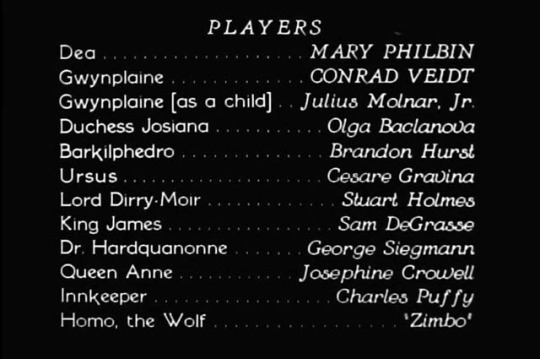
Before we start, let’s pan over the credits, specifically looking at the dog. Calling it Homo really throws me off at times. I’m not sure if it’s meant to be short for something but it’s kinda funny when it cuts to the text to show what the characters are saying and you get “Shut up, Homo!”.
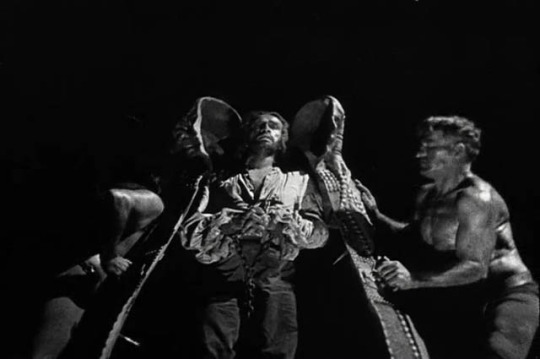
Our story takes place in 17th century England, with King James II dispatching with one of his rivals, Lord Clancharlie, who he sends to the Iron Lady, not Maggie Thatcher but some form of Iron Miaden device. To make matters worse, Clancharlie’s son has been sold off to Comprachicos who have disfigured him with a permanent Chelsea smile so that he may ‘laugh forever at his fool of a father’. The Comprachicos are banished and leave the child behind, he finds a blind baby beside its mother who has frozen to death and he seeks shelter at the caravan of Ursus.
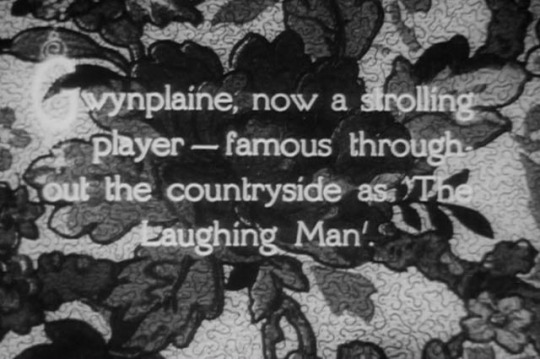
Time passes to the children all grown up and Gwynplaine is now famous as a travelling clown known as ‘The Laughing Man’. Hugh Morrus?

What’s really weird is that Gwynplaine and Dea are now romantically linked. Presumably they grew up together with a sibling sort of bond so that’s a bit creepy. He still has some reluctance though as he feels inadequate, thinking himself not good enough for her due to his disfigurement.

Meanwhile, Duchess Josiana takes a shine to him. Maybe she just has a thing for disfigurement or she’s just really put off by the man she’s arranged to be married to. Or maybe he’s put off by her, he looks a little Tutti Frutti, if you know what I mean...
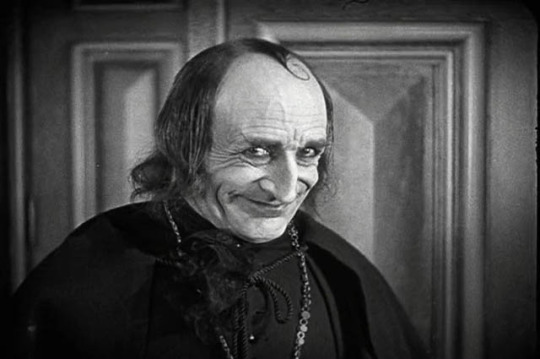
The former court jester Barkilphedro, now working under Queen Anne, comes to learn of the lineage of Gwynplaine but things don’t pan out quite as I was expecting. He always comes off quite devious so I thought he was going to start manipulating things to his own ends, maybe some blackmail here or there. It starts going that way as the Comprachico that originally discovered the truth is arrested and ‘dies’ under mysterious circumstances but Barkilphedro pretty much tells the Queen and she puts things in motion to have Gwynplaine restored to power and married to the Duchess so she can keep herself in the life she’s become accustomed. Maybe Bark is more loyal than I thought, he still acts in an underhanded manner by trying to separate Gwynplaine from his old life and Dea but he’s still acting in the interest of the royal family.
It’s definitely an emotional piece at times, just the general isolation that Gwynplaine has existed in from childhood and continues to suffer now with people mocking his appearance. There’s a bittersweet moment as well later on where the carnival has been led to believe that Gwynplaine has died whilst in custody but, in order to spare her feelings, Ursus tells everyone that the show must go on and the crew fake the sound of the cheering crowd. Even through his own grief, his main concern is to tell her to listen to the adoring crowd that loves Gwynplaine more than ever.
It feels a little long but I don’t know how much of that is down to having to stall so you can read the dialogue between characters or read signs or letters that would be quickly summed up through normal speech. It’s been a while since I’ve seen a silent movie, I always feel slightly lost during them as they’re something you have to focus on and my attention span always fails me. It is something that intrigues me though, the idea of them being more universal and being able to convey things through body language and facial expressions alone. Obviously Gwynplaine’s face is very striking but Ursus can be very expressive at times and Bark always seems to have a devilish look on his face.

In all of that near 2 hrs though, the biggest disappointment is that still couldn’t find time to show us the 5 legged cow. They talk up this big attraction as part of the freaks on show, like the two snouted pig, at the carnival but all we get is a distant crowd shot. Don’t promise a 5 legged cow if you can’t deliver!
3 notes
·
View notes
Text
L'homme qui rit (2012), The Grinning Man (2016), The Man Who Laughs Musical 웃는남자 (2018 - 2019/20)
I first heard about ‘The Man Who Laughs’ because of the South Korean musical version of the Novel.
From there I learned about Victor Hugo’s novel that was published in 1869 under the french title L'homme qui rit.
The story is set in 1680s -1700s England, during the reign of James II and Queen Ann. It depicts royalty, how aristocracy was so cruel and power-hungry at that time. Hugo’s intention was to show the parallels between England and the French reign of Louis-Philippe and the Régence.
‘The novel follows the life of a young nobleman called Gwynplaine who was disfigured by a perpetual grin as a child and left homeless. He stumbles upon a dead women who has frozen to death outside in the snow, but the baby girl in her arms was still alive Gwynplaine saves the baby and carries on until he meets a man called Ursus who owns a travelling theatre and invites the child to stay with him. 15 years later, Gwynplaine has turned into a brave young man by is still haunted by his disfigurement. The baby now named Dae grew into a beautiful women but was blinded by the cold. Between the two a romance has started to blossom, the two help Ursus put on shows where they tell the tale of Gwynplaine and end with him revealing his face so the crowds can laugh at his grotesque face.
One night a spoilt Duchess by the name of Josiana, who is also the illegitimate daughter of King James II decides she’s bored of the normal routine of court. Telling her fiancé, David Dirry-Moir who she has been engaged to since birth he tells her that the only cure for her boredom is Gwynplaine. So after this she decides to attend one of his performances, and is somewhat aroused by the combination of hid virile grace and his facial disfigurement. Later a agent of the court who wishes to destroy Josiana by getting her to marry the ‘clown’ meaning Gwynplaine, shows up at the caravan and some how gets Gwynplaine to follow him.
He is tricked into going in a London dungeon where he meets a physician named Hardquannone who is being tortured and killed, Hardquannone recognises Gwynplaine as the boy who he had arranged to be abducted and disfigured 23 years earlier. It’s revealed that during the reign of King James II in 165-1688, one of the king’s biggest enemies was a Lord Linnaeus Clancharlie, Marquis of Corleone, who had fled to Switzerland. When the Lord died the King had arranged an abduction of the lords then 2 year old son and heir, Fermain. The King then sold Fermain to a band of wanderers called ‘Comprachicos’ who were criminals that would disfigure and mutilate children, and then use this to force them to beg for alms, or to bring in money being exhibited as carnival freaks. This story is confirmed by a message in a bottle that Queen Anne received a short time before, the message was a last confession by the ‘Comprachicos’ before they perished in a storm. The message explains that they renamed the boy Gwynplaine and abandoned him in a heavy snowstorm before they set sail to sea. This letter also detailed that David Dirry-Moir is the illegitimate son of the Lord Linnaeus. Now that Gwynplaine is known to actually be Fermain and is alive and well, the inheritance that was promised to David on the condition that he marry Josiana will now instead go to Fermain. Gwynplaine is the arrested and Baekilphedro goes back and lies to Ursus and Dea telling them that Gwynplaine is dead.
Upon hearing the news Dea becomes ill with grief that her love is gone, to make matters worse the authorities exile them for using a wolf in their shows which is illegal. Meanwhile Josiana has Gwynplaine brought to him so that she can seduce him, but is interrupted by a pronouncement from the Queen. It informed her that David had been disinherited and that the Duchess must now marry Gwynplaine. Josiana however rejects him as a lover but agrees to marry him. Gwynplaine gets his title of Lord Farmain Clancharlie, Marquis of Corleone back and is permitted to sit in the house of lords. But when he addresses the peerage with a fiery speech against the inequality between the rich and the poor, the other Lords just laugh at Gwynplaine’s clownish grin. David comes to his defence and challenges a dozen Lords to duels however he also challenges Gwynplaine who’s speech had inadvertently condemned David’s mother, who had abandoned David’s father to become the mistress of Charles II.
Gwynplaine realising that this isn’t the life he wants renounces his peerage and sets out to find Ursus and Dea, but is unable to find them which nearly drives him to take his own life. He then learns of the deportation and swiftly finds the ship and reunites with them, the fragile Dea is ecstatic to have her love back but unfortunately dies abruptly. Ursus fainting at the sight. Gwynplaine in a trace, obviously devastated by the Death of his love walks along the deck while speaking to a dead Dea. He then throws himself into the sea and doesn’t resurface. When Ursus finally comes to, he’s met with the sight of Homo the wolf sitting by the ships rail howling at the sea.’
There has been many film adaptations of this Novel: - The Man Who Laughs (1909) Made in France by the Pathé film company, no copies of this film have known to survive. - Das grinsende Gesicht (The Grinning Face) 1921 silent film produced by Olympic Films. - The Man Who Laughs (1928) American silent film directed by Paul Leni, It stared Conrad Veidt who played Gwynplaine and this performance was a key influence on the character design for the comic book villain The Joker. - Clair de Lune (1932) French film that was based on the 1921 play, directed by Henri Diamant-Berger. - The Man Who Laughs (1966) (L'uomo che ride) Italian-French film, it also comes in a English dubbed version that’s titled ‘He Who Laughs’ which was made in Italy and directed by Sergio Corbucci. This story is inspired by the novel but takes a different path, almost making it into it’s own story. - L'homme qui rit (1971) TV movie directed by Jean Kerchbron, this was made into three episodes. - The Man Who Laughs (2012) French movie.
There has also been many Theatre adaptations: - Claire De Lune (1921) was a stage play written by Blanche Oelrichs but under her male persona Michael Strange. It ran for 64 performances from April to June. - The Man Who Laughs (2005) The Stolen Chair Theatre Company developed a ‘silent movie for stage.’ that drew inspiration from the Novel and the 1927 silent film. - The Man Who Laughs (2006) the story was adapted into a musical made by Alexandr Tyumencev who is a composer, and Tatyana Ziryanova who is a Russian lyrics. - The Man Who Laughs (2013) a musical version that featured a blend of Jewish, Gypsy and Russian style songs. - The Grinning Man (2016) is another musical adaptation that opened at the Bristol Old Vic, this versions does have some slight changes from the original story such as Gwynplaine is changed to Grinplaine. There is also use of Puppets. - The Man Who Laughs (2018) Musical adaptation written by Frank Wildhorn, this musical debuted in South Korea and stared Idol’s who played Gwynplaine such as Kim Junmyeon also known as Suho from Exo, Kyuhyun from Super Junior, Park Hyo Shin and Park Kang Hyun. This musical won three awards that included the Best Musical Award in the 2019 Korean Musical Awards.
There has also been a series of comic books made about The Man Who Laughs from 1950 up until 2013. I’m going to only talk about the 2018 musical, the 2012 film L'homme qui rit and 2016 The Grinning man because these are the ones that I’m familiar with. I’ll be starting out with the 2018 musical because this is the one that introduced me to The Man Who Laughs.
Source
I’ll be talking about:
* The Man Who Laughs (웃는남자) Korean Musical (2018 - 2019/20)
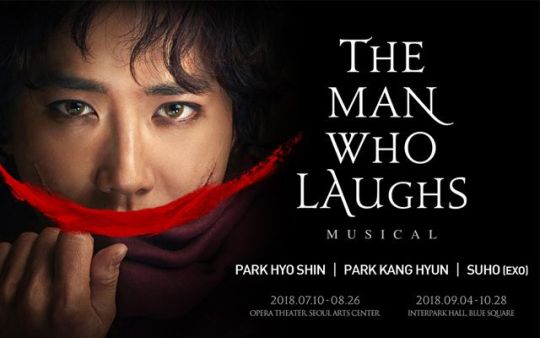
* The Man Who Laughs (L'homme qui rit) French Movie (2012)
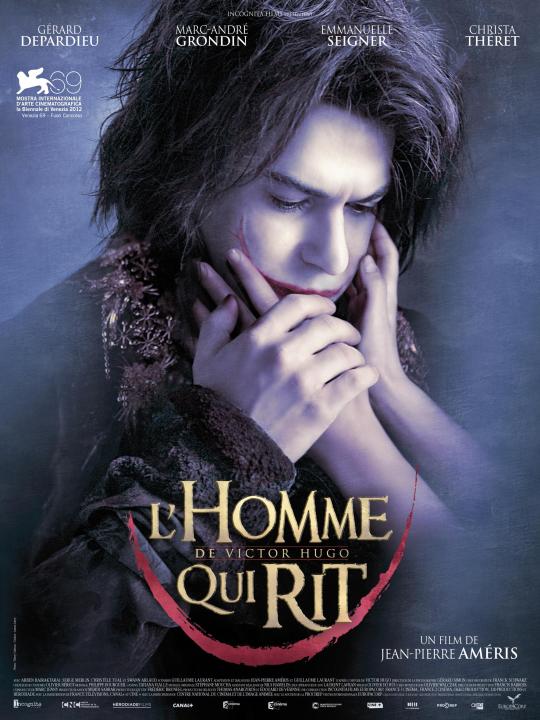
* The Grinning Man Bristol Old Vic Musical (2016)

#l’homme qui rit#the man who laughs#2012#the man who laughs 2012#the man who laughs musical#the man who laughs korean#웃는남자#the man who laughs 2018#the grinning man#the grinning man 2016#Gwynplaine#Suho#kim junmyeon#Dea#victor hugo#the man who laughs victor hugo#myeonplaine
0 notes
Text
screaming over the progression of Face Reveals in tgm, a post that is entirely too long.
like, the first time Gwynp takes off the bandages, it’s played up so much. there’s the music, the flashing lights, the Puppet. and then the lights go out and...it’s presented as a bit of a horror show, really. you’re left not quite sure what you saw, just that it was a shock. there’s a quick shift to the reactions, from Josiana and the rest of the in-show audience, rather than lingering on the face itself.
the second time, it’s within a dreamlike sequence. the unsettling vibe is still there, but not the rapid shock. instead, it’s slowed down, lingers. the lighting is still dim, but it isn’t flashing. when the people lift Gwynp up, it kind of serves as an invitation to look, though the moment still passes fairly quickly.
the third time, with Josiana, the lights are dim, there’s no flashing, no weird musical effects. the bandages don’t come off especially slowly. Gwynp’s face remains somewhat obscured just, given what’s going on. Josiana reacts to the wound, thirstily calling Gwynp an “abomination”
the fourth time, when Angelica takes the bandages off him (without consent, c’mon Angelica, that’s a no-no) Gwynp’s initially facing away from the audience, in addition to the light being dim. instead of getting a view of the wound, we mostly just see the Puppet during the next dreamlike sequence that follows, wherein the entire cast comes out to worship The Grinning Man.
( an aside - i wonder if these sequences with the Puppet, particularly its second and third appearances, are representative of Gwynplaine’s fear that this is all he is to people? initially, we see Ursus observing the people’s reaction to Gwynp, but not participating in their fervor. Later on, however, Ursus and Dea are present and join in the singing of, “Praise the Grinning Man” perhaps indicating Gwynp’s fears of not being perceived as anything other than his disfigurement and trauma might be getting worse. He always knew that’s all he was to the crowd, but it’s been creeping up on him that Dea and Ursus might, though for different reasons, see him the same way. hence the inclination in Freak Show and the first dream/Puppet sequence (and Brand New World to some extent) to just give up and embrace being that for everyone )
but then there’s the fifth time Gwynp is unmasked - and stays unmasked for the rest of the show. this time, nobody reacts, comments on it, or anything. the Puppet is nowhere to be seen. The, “then you realize that you are him and he is you” is repeated, but this time it’s calm and sober as compared to the previous instances. for once, it’s no longer about the reactions, it’s just there. And yeah, it is a terrible wound. It’s not pretty. But its exposure takes up very little of the focus of its screentime. This is...the first time the mask has come off without it being specifically because of someone wanting to see Gwynp’s face. He isn’t showing himself to a paying audience, or clamoring crowd, or intrigued potential lover or a queen. Maybe he wanted Barkilphedro to see the result of his actions, but it is entirely his choice, not something that’s being, even implicitly, asked of him. Also, with the wound remaining uncovered right through the end as Gwynp and Dea walk away toward their new life?
it’s been a recurring concept that Ursus wants Gwynp to let go of the past in order to start a new life, whereas Gwynplaine has been caught up in a need to remember the past and achieve revenge. Thing is, whether he did as Ursus wanted and gave up on the past, or went through with his desire for revenge...he would still always have to live with his disfigurement. He doesn’t have the luxury of entirely escaping his past, because it is literally carved into his face. But, he did finally get to have a choice in the matter. Choosing to remember instead of continuing to suppress the memories, choosing to let Barkilphedro live, and then, even, choosing to live with his wound. Given his fears of people not seeing him past his wound, to now be neither hiding it or leaning into other people’s expectations surrounding it, it seems like he’s at least begun to make peace with it.
( also there’s probably an argument to be made that the five instances fit both some of the lyrics with, “at first you shudder with the shock”, and a, possibly rearranged version of, the five stages of grief, but that’s another thought )
#gwynplaine#i feel like this is fairly incoherent in places but idc#if anyone wants to articulate this better pls be my guest but i'm just so !!!!!!!! about it#tgm#the grinning man
41 notes
·
View notes